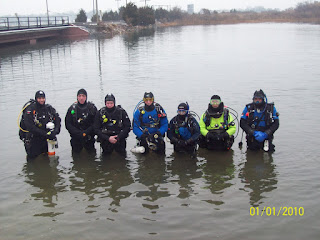
For the middle of winter, this was an interesting day. It started when Flo Melo, our Assistant Dive Chief, got a call from the Marine Mammal Stranding Center to investigate two more local seal sightings in Manasquan and Brielle, neighboring towns just to the north across the Manasquan River. Throughout our winter, it is very common for seals to come ashore to rest or nap, but this isn't common knowledge. When Flo and Tom went to evaluate the harbor seal on the beach, some bystanders weren't even aware that there were ANY seals in New Jersey. Consulting with the MMSC via cell phone, it was determined that this one was in no distress and required no human assistance other than to be left alone. When we returned later in the afternoon, all that was left was a set of flipper tracks back to the ocean. The second seal, laying on a dock in Brielle, was even a little feisty, vocally letting Flo and Tom know that he did indeed wish to be left alone. We are told that every holding tank in the Stranding Center's Brigantine facility is full right now, so this was good news for everyone!

The Dive Team then conducted an ice rescue drill with the Mantoloking Fire Department. Our Squad provides coverage for Point Pleasant Beach, BayHead, and Mantoloking, so this was a great opportunity to work with other emergency service volunteers who might one day provide us surface support. It was 40 degrees, windy, and rainy, but everyone was ready to drill. Chief Nesley first demonstrated to the firefighters to how to evaluate ice conditions, especially if properly suited divers are not yet available to assist with an ice rescue. The firefighters were then introduced to the drysuits that our divers are outfitted with, and they practiced helping a diver into the suit. We were
especially concerned with proper handling of the suit's zipper and ensuring proper neck seals.

We then went though various shore support and rescue options for the firefighters. Everyone took their turns with throw bags, the safest way to get a line out to someone in ice without risking someone else falling through. We then demonstrated backboard use to remove a victim from an ice hole, and the firefighters got the feel of hauling the board back to shore. We also might call upon the Fire Department to tend line for us. Just like last week's ice diving drill, we practiced tying appropriate knots for a diver's harness. Several of the firefighters also got a feel of our line pull system of communication.

We had a lot of line to clean, but the firefighters were introduced to the equipment we might use and now know what to expect during an ice rescue. We are thankful to know that one day they could have our backs.

.











